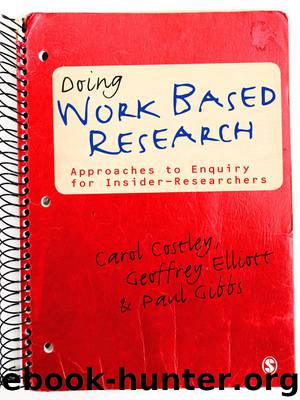Doing Work Based Research: Approaches to Enquiry for Insider-Researchers by Carol Costley & Geoffrey C Elliott & Paul Gibbs

Author:Carol Costley & Geoffrey C Elliott & Paul Gibbs [Costley, Carol]
Language: eng
Format: azw3
ISBN: 9781446242377
Publisher: SAGE Publications
Published: 2010-03-15T04:00:00+00:00
Interviews
Interviewing is a widely used research technique that can be adapted to work in a wide range of situations to gain information about people’s perceptions, experiences or preferences. Interviews can be conducted face-to-face, on the telephone or, in some cases, through online ‘chat’. It is possible to use structured interviews to produce easily compared answers, semi-structured interviews where open questions can be followed by more structured ones, and discussions-as-interviews with no pre-set questions and where discussion progresses around a broad theme agreed between researcher and interviewee. At all levels of structure, one of the advantages of interviews over questionnaires is that they allow the researcher to explore areas of ambiguity and seek clarification; the main disadvantage is the length of time they occupy, and the fact that the interviewee’s identity cannot be kept hidden from the researcher (unless third-party interviewers are used).
Structured interviews are sometimes described as questionnaires administered verbally, although there are some important differences. The interviewer is able to ask questions in sequence without disclosing later questions, and it is slightly easier – and less confusing to the interviewee – to branch off in different directions according to the answer to a previous question. Structured interviews are generally recorded on a proforma that resembles a questionnaire and may contain space for short, written answers, use tick boxes, yes/no or numerical responses, or have multiple-choice answers. The design of schedules and questions for both structured and semi-structured interviews has much in common with questionnaire design, covered below.
Semi-structured interviews tend to use a schedule of questions in the same way as structured interviews, but allow more open verbal answers which are either written down by the researcher on a proforma or, ideally, recorded. They give participants more latitude in responding in their own words, but can also be focused using specific questions in response to a general answer. Both semi-structured and structured interviews can be carried out by telephone, although the former are more time-consuming and typically require advance notification.
Unstructured interviews are generally discussions around broad themes agreed in advance between researcher and interviewee and carried out face to face. Their direction can be influenced by the interviewee as much as the researcher. They do not have preset schedules, although it is usual to have a brief, written explanation as part of the agreement with the participants. Sometimes they are undertaken as a sequence, either over time for longitudinal research or simply to provide more time and allow the researcher to consider what was discussed in one session before going on to the next. It is usual to record and transcribe unstructured interviews, and provide a copy of the transcript(s) to the interviewee for checking; sometimes a final session can be used to go over and discuss matters arising from the transcript, although discussion from this will need to be recorded and noted separately. Unstructured interviews are good for revealing deep information and understanding, but require a high level of skill on the part of the interviewer and are also very time-consuming to conduct and analyse.
Download
This site does not store any files on its server. We only index and link to content provided by other sites. Please contact the content providers to delete copyright contents if any and email us, we'll remove relevant links or contents immediately.
The Art of Coaching Workbook by Elena Aguilar(50079)
Trainspotting by Irvine Welsh(20987)
Twilight of the Idols With the Antichrist and Ecce Homo by Friedrich Nietzsche(18287)
Fangirl by Rainbow Rowell(8775)
Periodization Training for Sports by Tudor Bompa(7901)
Change Your Questions, Change Your Life by Marilee Adams(7345)
This Is How You Lose Her by Junot Diaz(6420)
Asking the Right Questions: A Guide to Critical Thinking by M. Neil Browne & Stuart M. Keeley(5339)
Grit by Angela Duckworth(5280)
Red Sparrow by Jason Matthews(5181)
Paper Towns by Green John(4775)
Room 212 by Kate Stewart(4721)
Ken Follett - World without end by Ken Follett(4429)
The Sports Rules Book by Human Kinetics(4062)
Housekeeping by Marilynne Robinson(4044)
Double Down (Diary of a Wimpy Kid Book 11) by Jeff Kinney(3904)
Papillon (English) by Henri Charrière(3889)
Exercise Technique Manual for Resistance Training by National Strength & Conditioning Association(3771)
The Motorcycle Diaries by Ernesto Che Guevara(3766)
